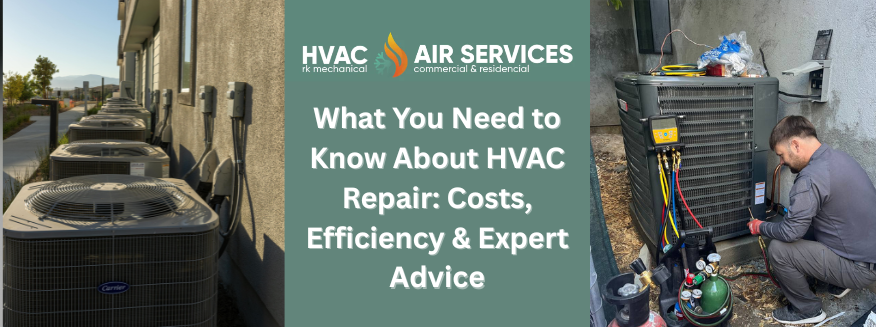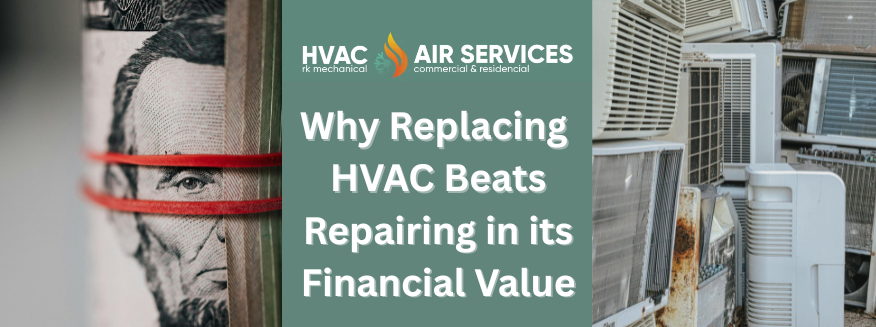Your furnace is at the heart of your home’s comfort during the cold months, silently working to keep you and your family warm. But what happens when it starts making strange furnace noises? A banging, squealing, or humming furnace isn’t just annoying—it’s a clear sign of an issue waiting to grow worse. These sounds are not random; they often reveal underlying mechanical problems, electrical faults, or airflow disruptions.
Listen to this podcast on the same topic:
The real danger? Ignoring these noises. That irritating sound today could mean costly breakdowns or even safety hazards tomorrow. Unusual furnace noises often signal that parts of the system are struggling to work properly. Acting early can mean the difference between a minor repair and a full system replacement.
In this guide, we’ll walk you through five of the most common furnace noises, explaining what they sound like, their causes, and what you should do about them. With timely action and consistent maintenance, you can keep your furnace operating quietly, efficiently, and safely. Let’s dive in.
1. Banging or Popping Noises
Banging or popping noises are startling, loud, and impossible to ignore. These sounds often occur during startup or as the furnace is cycling, resembling small explosions or sharp pops. When your system makes this type of furnace noise, it’s a red flag that requires prompt attention.
Potential Causes
1. Delayed Ignition
Over time, the burners in your furnace can accumulate dirt and grime. When gas flows into the combustion chamber, dirty burners delay ignition, causing gas to build up. Once it ignites, it creates a small explosion—a loud, unsettling bang.
2. Expanding or Contracting Ductwork
When hot air flows into cold metal ducts, the temperature change causes the metal to expand, creating a popping sound. Similarly, as the furnace shuts off and the ducts cool, the metal contracts, making the noise again. Insufficient insulation can worsen these effects.
Implications
Delayed ignition is not something to brush off. The mini explosions stress the heat exchanger, one of the most critical and expensive parts of your furnace. Over time, this stress can cause cracks, which may allow carbon monoxide—a deadly, odorless gas—to leak into your home. Ductwork noises, while less dangerous, indicate efficiency issues. Expanding and contracting ducts can eventually wear out connections or joints, causing airflow problems.
Recommended Actions
To resolve delayed ignition, schedule a furnace inspection immediately. A professional HVAC technician will clean the burners, ensuring gas flows smoothly and ignites on time. This simple maintenance step eliminates the risk of dangerous gas buildup.
For ductwork noises, improving insulation is key. Insulating ducts reduces temperature swings, minimizing the expansion and contraction that causes popping. Reinforcing duct connections can also quiet the noise and improve airflow efficiency.
2. Squealing or Screeching Sounds
If you hear a high-pitched squealing or screeching sound, it’s usually mechanical. These sharp noises are hard to miss and indicate that certain components in your furnace are wearing out or struggling to function properly.
Potential Furnace Noises Causes
1. Worn-Out Blower Belt
This belt connects the motor to the blower fan, ensuring warm air circulates through your home. Over time, the belt can fray, slip, or become misaligned, creating a loud squeal as it struggles to rotate.
2. Dry or Damaged Motor Bearings
Bearings reduce friction in the motor as it spins, but without proper lubrication, they grind against each other, producing a screeching sound.
3. Malfunctioning Blower Motor
If internal parts of the blower motor are damaged or the motor itself is strained, it creates sharp, unpleasant noises.
Implications
Ignoring a squealing furnace can lead to a chain reaction of bigger problems. A loose or damaged belt can snap, leaving the blower unable to distribute warm air. This reduces efficiency and can lead to furnace shutdown.
Similarly, dry bearings or motor issues strain the entire system, shortening its lifespan and increasing repair costs.
Recommended Actions
Begin by inspecting the blower belt. If it looks loose, frayed, or cracked, it’s time for a replacement. Additionally, lubricating motor bearings regularly can prevent unnecessary friction and extend their lifespan.
If the blower motor itself is failing, contact an HVAC technician. They can diagnose the problem and repair or replace the motor as needed. Professional servicing will not only silence the screeching furnace noise but also restore your system’s performance.
3. Rattling or Clanking Noises
Rattling or clanking noises coming from your furnace are more than just an annoyance—they’re a sign that something is loose, damaged, or misaligned inside the system. These sounds often start as faint rattles, but if ignored, they can quickly grow louder and more disruptive. What may begin as a minor issue can escalate into a costly repair if left unchecked.
Potential Furnace Noises Causes
1. Loose Screws, Panels, or Internal Components
Over time, constant furnace vibrations during operation can loosen screws, panels, or internal parts. As these components rattle, they create metallic noises that may seem minor at first.
2. Damaged or Unbalanced Blower Wheel
The blower wheel is responsible for pushing warm air through your home. If it becomes unbalanced or damaged, it can knock against the blower housing or other internal components, producing a clanking sound. This often happens due to wear, dirt buildup, or poor alignment, and it places strain on the blower motor.
3. Cracked Heat Exchanger
This is the most serious cause of rattling noises. A cracked heat exchanger not only produces unsettling sounds but also poses a significant safety risk. The heat exchanger can crack due to prolonged stress, overheating, or poor ignition timing. As the furnace runs, the cracked part may vibrate, creating a rattling sound.
Implications
Rattling sounds might seem harmless, but the consequences of ignoring them can be severe:
Loose screws and panels can vibrate against nearby parts, causing unnecessary wear and tear. Over time, what starts as a simple tightening job can turn into costly repairs as components wear out faster than expected. Moreover, a damaged blower wheel puts stress on the blower motor, forcing it to work harder to circulate air.
If this continues, the motor itself can overheat or fail, leaving your home without heat and driving up repair costs. Also, a cracked heat exchanger is a critical safety hazard. When damaged, it can release carbon monoxide—a colorless, odorless gas—into your home. Carbon monoxide exposure can cause headaches, nausea, and even life-threatening situations.
Recommended Actions
To resolve rattling or clanking noises effectively: Tighten anything that seems loose to prevent unnecessary vibrations. This is an easy way to stop minor rattling before it worsens. If the noise persists, the blower wheel may need inspection. A professional HVAC technician can assess whether the blower wheel is damaged, unbalanced, or misaligned. Taking prompt action not only prevents costly repairs but also keeps your home safe and your furnace running efficiently.
4. Humming or Buzzing Sounds
Humming or buzzing noises coming from your furnace are subtle but shouldn’t be ignored. While these sounds are often quieter than banging or rattling, they are typically a sign of electrical or mechanical strain. If addressed early, these issues can be resolved before they lead to bigger, more expensive problems.
Potential Furnace Noises Causes
1. Faulty Transformer or Capacitor
Transformers and capacitors regulate the power within your furnace. When these components malfunction or wear out, they often vibrate, creating a humming or buzzing noise. This is a common issue in older furnaces but can occur in newer ones if electrical connections are loose.
2. Loose Wiring or Components
Electrical connections can loosen over time due to vibrations or poor installation. Loose wires can hum or buzz as electricity passes through them, creating a continuous low-pitched sound during operation.
3. Blower Motor Strain Due to Restricted Airflow
If the air filter is clogged or vents are blocked, the blower motor has to work harder to circulate air. This added strain causes the motor to hum or buzz louder than normal. Over time, this extra workload can lead to overheating and motor failure.
Implications
Faulty transformers, capacitors, or loose wiring are potential fire hazards. Ignoring these buzzing sounds could increase the risk of electrical shorts, sparks, or even furnace fires. A strained blower motor consumes more energy, increasing utility bills while reducing overall furnace efficiency. If not addressed, the motor may eventually fail, leading to costly repairs or replacements.
Recommended Actions
Humming noises caused by electrical issues should always be addressed by a licensed HVAC technician. Dirty filters restrict airflow, straining the blower motor. Ensure vents and registers are clear of debris and obstructions to reduce strain. If loose components or wires are the culprit, they should be secured or replaced promptly to prevent further noise or hazards.
5. Clicking or Tapping Noises
Clicking or tapping sounds are often repetitive and occur during furnace startup or shutdown. While faint clicking can be normal, loud or constant clicking signals a deeper problem that needs attention.
Potential Furnace Noises Causes
1. Ignition System Problems
A malfunctioning igniter or pilot light may cause repeated clicking as the system struggles to ignite. This can occur when gas flow is disrupted, or the igniter is worn out.
2. Faulty Relay Switches
Electrical relays control the flow of power to various furnace components. When these relays fail, they may click repeatedly as they attempt to engage or disengage.
3. Debris in the Blower Fan
Dust, dirt, or small foreign objects can get caught in the blower fan, causing a tapping noise as the fan blades rotate.
Implications
A faulty ignition system can prevent the furnace from igniting, leaving you without heat when you need it most. Clicking from electrical relays or obstructions can strain internal components, increasing the risk of a full system shutdown.
Recommended Actions
Contact a technician to inspect and clean the igniter, pilot light, and gas flow system. Replacing worn-out ignition components resolves most startup issues. Check for debris or obstructions in the blower assembly. Keeping the fan clean reduces tapping noises and ensures proper airflow. If clicking comes from electrical relays, have them tested and replaced by a professional. This ensures the system operates without interruptions.
Preventative Maintenance Tips
A quiet, efficient furnace starts with regular care. With a few key steps, you can avoid odd noises, unexpected breakdowns, and costly repairs. Here’s how to keep your system running at its best:
1. Schedule Regular Inspections
A yearly inspection is the easiest way to keep furnace problems in check. A professional technician can catch small issues—like dirty burners or loose parts—before they turn into bigger, noisier problems. These tune-ups ensure your system runs smoothly and quietly, keeping you warm all season without surprise breakdowns.
2. Replace Air Filters
Dirty filters are a furnace’s worst enemy. When airflow gets restricted, your system works harder, leading to buzzing, humming, or rattling noises. Replace or clean filters monthly during heavy usage to keep airflow smooth and components strain-free. It’s a quick fix that prevents noise and improves efficiency.
3. Clean and Insulate Ductwork
Dusty, clogged ducts can disrupt airflow, causing popping or banging sounds. Regularly clean your ductwork to remove debris and seal any loose joints. Adding insulation minimizes expansion noises when the furnace runs, making your home warmer and quieter.
4. Book Professional Servicing
Seasonal HVAC tune-ups are non-negotiable for a healthy furnace. A certified technician will inspect key components like the blower motor, ignition system, and electrical connections. This eliminates noise sources, prevents wear and tear, and extends your furnace’s lifespan.
Unusual furnace noise is your system’s way of warning you. Whether it’s a rattling panel, a buzzing motor, or a clicking ignition, each sound has a cause—and a solution. Addressing these issues promptly prevents costly repairs, improves efficiency, and ensures your home stays safe and warm all winter long. For peace of mind, schedule regular inspections and contact a professional at the first sign of trouble.





































